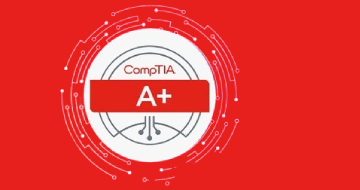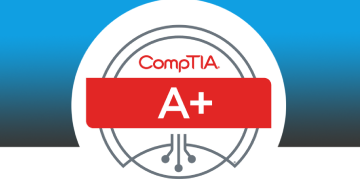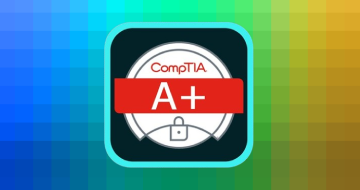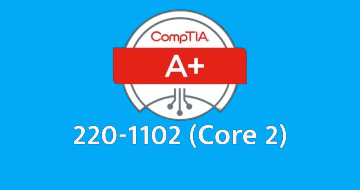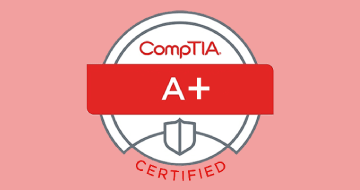IIRF Online > IT & Software > IT Certifications > CompTIA A+ > CompTIA A+ Core 1 (220-1101) Complete Course & Practice Exam
CompTIA A+ Core 1 (220-1101) Complete Course & Practice Exam by Udemy
Pass the CompTIA A+ (220-1101) Core 1 exam with help from a top expert in the field!
Course Highlights
- How to pass the CompTIA A+ (220-1101) Core 1 exam on your first attempt
- What your weak areas are in the CompTIA A+ curriculum so you can restudy those areas
- Install, configure, and maintain computer equipment, mobile devices, and software for end users
- Service components based on customer requirements
- Understand networking basics and apply basic cybersecurity methods to mitigate threats
- Properly and safely diagnose, resolve, and document common hardware and software issues
- Apply troubleshooting skills and provide customer support using appropriate communication skills
- Understand the basics of scripting, cloud technologies, virtualization, and multi-OS deployments in corporate environments
Skills you will learn!
Curriculum
8 Topics
Welcome
Download your free study guide
Exam Tips
Personal Computers
Safety Procedures
Troubleshooting Methodology (OBJ. 5.1)
Custom PC Build
Checkpoint: Introduction
6 Topics
Cable Types (OBJ. 3.1)
Exterior of a PC (OBJ. 3.1)
USB Cables (OBJ. 3.1)
Video Cables (OBJ. 3.1)
Storage Cables (OBJ. 3.1)
Checkpoint: Cable Types
11 Topics
Motherboards (OBJ. 3.4)
Form Factors (OBJ. 3.4)
CPU Architecture (OBJ. 3.4)
CPU Sockets (OBJ. 3.4)
CPU Features (OBJ. 3.4)
Motherboard Connections (OBJ. 3.4)
Installing the Motherboard & CPU (OBJ. 3.4)
Expansion Cards (OBJ. 3.4)
Expansion Card Types (OBJ. 3.4)
Installing Expansion Cards (OBJ. 3.4)
Checkpoint: Motherboards
10 Topics
Cooling and Power (OBJ. 3.4 & 3.5)
Cooling the System (OBJ. 3.5)
Liquid Cooling (OBJ. 3.5)
Installing Active Cooling (OBJ. 3.5)
Power Supply Unit (PSU) (OBJ. 3.5)
Power Supply Connectors (OBJ. 3.5)
Input and Output Voltages (OBJ. 3.4)
Wattage Rating (OBJ. 3.4)
Installing a Power Supply (OBJ. 3.4)
Checkpoint: Cooling and Power
8 Topics
System Memory (OBJ. 3.2)
Addressing Memory (OBJ. 3.2)
Memory Modules (OBJ. 3.2)
Multi-Channel Memory (OBJ. 3.2)
ECC Memory (OBJ. 3.2)
Virtual Memory (OBJ. 3.2)
Installing Memory (OBJ. 3.2)
Checkpoint: System Memory
8 Topics
BIOS/UEFI (OBJ. 3.4)
Boot Options (OBJ. 3.4)
BIOS/UEFI Security (OBJ. 3.4)
TPM and HSM (OBJ. 3.4)
BIOS/UEFI Cooling Options (OBJ. 3.4)
Configuring the BIOS (OBJ. 3.4)
Configuring the UEFI (OBJ. 3.4)
Checkpoint: BIOS/UEFI
9 Topics
Storage Devices (OBJ. 3.3)
Hard Disk Drive (HDD) (OBJ. 3.3)
Solid State Drive (SSD) (OBJ. 3.3)
RAID (OBJ. 3.3)
Removable Storage (OBJ. 3.3)
Optical Drives (OBJ. 3.3)
Installing Storage Devices (OBJ. 3.3)
Configuring a RAID (OBJ. 3.3)
Checkpoint: Storage Devices
9 Topics
Virtualization Concepts (OBJ. 4.2)
Virtualization (OBJ. 4.2)
Containerization (OBJ. 4.2)
Purposes of VMs (OBJ. 4.2)
Resource Requirements (OBJ. 4.2)
Security Requirements (OBJ. 4.2)
Configuring Virtual Machines (OBJ. 4.2)
Securing Virtual Machines (OBJ. 4.2)
Virtualization Concepts
9 Topics
Cloud Computing (OBJ. 4.1 & 2.2)
Characteristics of the Cloud (OBJ. 4.1)
Cloud Deployment Models (OBJ. 4.1)
Cloud Service Models (OBJ. 4.1)
Virtual Desktop Infrastructure (VDI) (OBJ. 4.1)
Cloud Storage Services (OBJ. 4.1)
Software Defined Network (SDN) (OBJ. 2.2)
Using the Cloud (OBJ. 4.1)
Cloud Computing
12 Topics
Networking Basics (OBJ. 2.2 2.4 2.7 2.8 & 3.1)
Networking Hardware (OBJ. 2.2)
Network Types (OBJ. 2.7)
Internet of Things (OBJ. 2.4)
Twisted Pair Cables (OBJ. 3.1)
Optical Cabling (OBJ. 3.1)
Coaxial Cabling (OBJ. 3.1)
Networking Tools (OBJ. 2.8)
Building a Cable (OBJ. 2.8)
Wiring the Network (OBJ. 2.8)
Testing the Network (OBJ. 2.8)
Networking Basics
8 Topics
Wireless Networks (OBJ. 2.3)
Wireless Frequencies (OBJ. 2.3)
Wireless Standards (OBJ. 2.3)
Wireless Security (OBJ. 2.3)
Fixed Wireless (OBJ. 2.3)
NFC RFID IR and Bluetooth (OBJ. 2.3)
Configuring a Wireless Network (OBJ. 2.3)
Wireless Networks
9 Topics
Internet Connections (OBJ. 2.7)
Dial-up and DSL (OBJ. 2.7)
Cable Connections (OBJ. 2.7)
Fiber Connections (OBJ. 2.7)
Cellular Connections (OBJ. 2.7)
WISP Connections (OBJ. 2.7)
Satellite Connections (OBJ. 2.7)
Hands-on with WANs (OBJ. 2.7)
Internet Connections
12 Topics
Network Configurations (OBJ. 2.1 2.5 & 2.6)
IPv4 (OBJ. 2.5)
Assigning IPv4 Addresses (OBJ. 2.5)
DHCP (OBJ. 2.6)
DNS (OBJ. 2.6)
VLAN (OBJ. 2.6)
VPN (OBJ. 2.6)
IPv6 (OBJ. 2.5)
Ports and Protocols (OBJ. 2.1)
TCP Versus UDP (OBJ. 2.1)
Configure a SOHO Network (OBJ. 2.5)
Network Configurations
14 Topics
Network Services (OBJ. 2.4)
File and Print Servers (OBJ. 2.4)
Web Servers (OBJ. 2.4)
Email Servers (OBJ. 2.4)
AAA Servers (OBJ. 2.4)
Remote Access Servers (OBJ. 2.4)
Network Monitoring Servers (OBJ. 2.4)
Proxy Servers (OBJ. 2.4)
Load Balancers (OBJ. 2.4)
Unified Threat Management (OBJ. 2.4)
ICS/SCADA (OBJ. 2.4)
Embedded Systems (OBJ. 2.4)
Legacy Systems (OBJ. 2.4)
Network Services
8 Topics
Mobile Devices (OBJ. 1.2 1.3 & 1.4)
Mobile Display Types (OBJ. 1.2)
Mobile Device Components (OBJ. 1.2)
Mobile Device Accessories (OBJ. 1.3)
Mobile Device Wireless Connectivity (OBJ. 1.3 & 1.4)
Mobile Device Wired Connectivity (OBJ. 1.3)
Port Replicators & Docking Stations (OBJ. 1.3)
Mobile Devices
10 Topics
Mobile Applications (OBJ. 1.4)
Mobile Device Synchronization (OBJ. 1.4)
Data for Synchronization (OBJ. 1.4)
Synchronization Methods (OBJ. 1.4)
MDM and MAM (OBJ. 1.4)
Multifactor Authentication (MFA) (OBJ. 1.4)
Location Services (OBJ. 1.4)
Mobile Email Configuration (OBJ. 1.4)
Configuring Mobile Email (OBJ. 1.4)
Mobile Applications
9 Topics
Laptop Hardware (OBJ. 1.1)
Security Components (OBJ. 1.1)
Disassembling a Laptop (OBJ. 1.1)
Replacing a Battery (OBJ. 1.1)
Replacing the Keyboard (OBJ. 1.1)
Upgrading the Memory (OBJ. 1.1)
Adding Expansion Cards (OBJ. 1.1)
Replacing the Storage (OBJ. 1.1)
Laptop Hardware
9 Topics
Printers and MFDs (OBJ. 3.6)
Unboxing and Setup (OBJ. 3.6)
Printer Connectivity (OBJ. 3.6)
Printer Drivers (OBJ. 3.6)
Printer Configuration Settings (OBJ. 3.6)
Sharing Print Devices (OBJ. 3.6)
Securing Print Devices (OBJ. 3.6)
Scanning Services (OBJ. 3.6)
Printers and MFDs
9 Topics
Printer Types (OBJ. 3.7)
Laser Printers (OBJ. 3.7)
Laser Printer Maintenance (OBJ. 3.7)
Inkjet Printers (OBJ. 3.7)
Inkjet Printer Maintenance (OBJ. 3.7)
Thermal Printers (OBJ. 3.7)
Impact Printers (OBJ. 3.7)
3-D Printers (OBJ. 3.7)
Printer Types
8 Topics
Troubleshooting Methodology (OBJ. 5.1)
Identify the Problem (OBJ. 5.1)
Establish a Theory (OBJ. 5.1)
Test the Theory (OBJ. 5.1)
Establish a Plan of Action (OBJ. 5.1)
Verify System Functionality (OBJ. 5.1)
Documentation (OBJ. 5.1)
Troubleshooting Methodology
10 Topics
Troubleshooting Hardware Issues (OBJ. 5.2)
Power Issues (OBJ. 5.2)
POST Issues (OBJ. 5.2)
Crash Screens (OBJ. 5.2)
Cooling Issues (OBJ. 5.2)
Physical Component Damage (OBJ. 5.2)
Performance Issues (OBJ. 5.2)
Inaccurate System Date/Time (OBJ. 5.2)
Smoke Test (OBJ. 5.2)
Troubleshooting Hardware Issues
6 Topics
Troubleshooting Storage Devices (OBJ. 5.3)
Boot Issues (OBJ. 5.3)
Storage Device Issues (OBJ. 5.3)
Drive Performance Issues (OBJ. 5.3)
Issues with RAIDs (OBJ. 5.3)
Troubleshooting Storage Devices
5 Topics
Troubleshooting Video Issues (OBJ. 5.4)
Physical Cabling and Source Selection (OBJ. 5.4)
Projector Issues (OBJ. 5.4)
Video Quality Issues (OBJ. 5.4)
Troubleshooting Video Issues
7 Topics
Troubleshooting Networks (OBJ. 5.7)
Wired Connectivity Issues (OBJ. 5.7)
Network Performance Issues (OBJ. 5.7)
Wireless Connectivity Issues (OBJ. 5.7)
VoIP Issues (OBJ. 5.7)
Limited Connectivity Issues (OBJ. 5.7)
Troubleshooting Networks
7 Topics
Troubleshooting Mobile Devices (OBJ. 5.5)
Mobile Power Issues (OBJ. 5.5)
Mobile Hardware Issues (OBJ. 5.5)
Mobile Display Issues (OBJ. 5.5)
Mobile Connectivity Issues (OBJ. 5.5)
Mobile Malware Infections (OBJ. 5.5)
Troubleshooting Mobile Devices
7 Topics
Troubleshooting Print Devices (OBJ. 5.6)
Printer Connectivity Issues (OBJ. 5.6)
Print Feed Issues (OBJ. 5.6)
Print Quality Issues (OBJ. 5.6)
Print Finishing Issues (OBJ. 5.6)
Print Job Issues (OBJ. 5.6)
Troubleshooting Print Devices
3 Topics
Conclusion
CompTIA A+ Core 1 (220-1101) Practice Exam
BONUS: Where to go from here?

CompTIA A+ Core 1 (220-1101) Complete Course & Practice Exam
